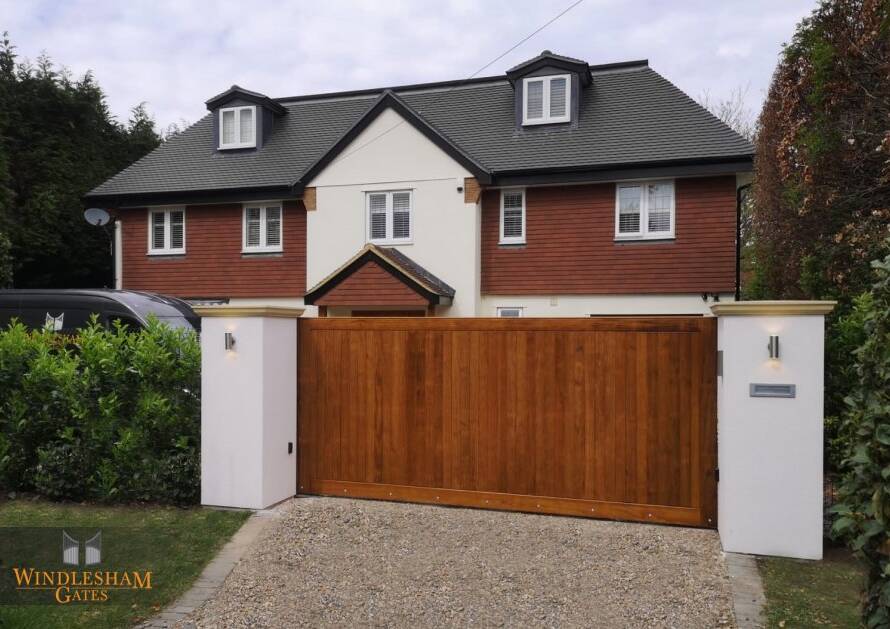At Windlesham Gates, we know better than anyone that electric gates are much more than just an entrance. They are a smart investment for UK homes or businesses, a statement of style, a mark of security, and a daily source of convenience. As one of the UK’s leading electric gate designers, manufacturers, and installers, we take pride in creating reliable systems that stand the test of time.
But, like all automated equipment, even the best-crafted electric gates can occasionally encounter problems, particularly if regular maintenance is overlooked or the gates have been exposed to harsh weather.
If your gate is stuck, moving sluggishly, making strange noises, or simply not behaving as it should, you’re not alone. This guide to troubleshooting common electric gate problems will help you understand what the issue could be and decide whether a DIY fix is safe, or if it’s time to call in the professionals.
Our aim is to give you confidence, while reminding you of the importance of proper electric gate maintenance to keep your investment running at its best.
Essential Safety Reminder
Before you do anything, always prioritise safety. Electric gates involve both electrical and mechanical components, which can pose serious risks if mishandled.
Always cut the power before inspecting your system. If you’re at all unsure, it’s much safer to contact professionals and let our qualified engineers take care of it.
Troubleshooting Common Electric Gate Problems
Gate Won’t Open or Close
One of the most common issues we’re called out for is a gate that simply refuses to open or close. There are several possible causes.
Sometimes the power supply has been interrupted. Check your fuse box or consumer unit to see if a circuit has tripped or a fuse has blown, as this is a surprisingly common reason electric gates stop working.
If you can open the gate manually but it won’t move automatically, it suggests the motor, control board, or power source may have failed. In this case, a professional inspection is usually required to pinpoint and rectify the fault.
Remote Controls or Keypads Are Not Working
Troubleshoot Steps:
- Replace batteries — flat batteries are a common fault in remotes and keypads.
- Clear obstructions — make sure the antenna and signal pathway are free from debris or interference.
- Reprogram remotes/keypads — loss of connection may require a reset using the user manual.
Gate Making Unusual Noises (Grinding, Screeching, Banging)
- Worn mechanical parts: Noise usually indicates wear and tear—inspect rollers, hinges, or gear mechanisms.
- Track obstructions: Sticks, stones, and gravel can get lodged in tracks, especially on sliding gates.
Gate Stops Mid-Cycle or Reverses
- Sensor alignment issues: Infrared safety beams prevent the gate from closing when an obstacle is detected. Misalignment or dirt on sensors can trigger a false response.
- Obstructions: Check for small items like leaves, bags, or even shadows interfering with sensors.
Sluggish or Hesitant Gate Movement
- Lack of lubrication: Dry or dirty rollers and hinges will increase resistance and slow operation.
- Motor strain: Heavier gates or poor alignment can cause the motor to struggle. Worn motor gears are also a potential cause.
Stuck in Manual Mode
- Power cut recovery: If there was a recent power outage, the gate might remain in manual mode. Restore power and check if it automatically resets.
- Check the manual release: Ensure it’s not still engaged or jammed.
Gate Won’t Close After Power Cut
- Travel limits reset: When power is restored, some gates need to relearn their open and close limits.
- Install a backup battery: This keeps the system functioning during outages and avoids misalignment.
Control Board or Electronics Faults
- Short circuits or water ingress: These can cause the gate to behave erratically. Look for signs of rust, burn marks, or dampness in the control panel.
- Loose wiring: Over time, vibrations or rodents may loosen or damage electrical connections.
Mechanical Wear and Tear on Rollers, Tracks, Hinges
- Track damage: Bent or worn tracks will misguide sliding gates, causing them to stick or stop.
- Worn bearings: Regular lubrication and occasional replacement are required for rollers and hinges, especially in older systems.
Weather-Related Gate Issues in the UK
Cold Weather Issues
- Frozen parts: Water can freeze in locks or hinges, especially in metal gates.
- Sluggish operation: Motors may run slower in sub-zero conditions, particularly older models.
Rain and Damp
- Short circuits or faulty sensors: Moisture can seep into sensor lenses or control boards.
- Gate movement issues: Waterlogged ground can cause misalignment or affect stability.
Summer Heat
- Sensor glare: Bright sunlight can confuse infrared sensors, causing gates to stop or reverse.
- Thermal expansion: Metal expands in heat, which can alter alignment or increase resistance in tracks.
Preventative Maintenance Tips
Routine care significantly reduces the chance of faults. Here’s a seasonal maintenance schedule:
Monthly
- Clear dirt and leaves from tracks and around the motor.
- Wipe clean sensors and gate safety edges.
- Check that remotes, keypads, and fobs are responsive.
Quarterly
- Lubricate moving parts with gate-specific grease.
- Check hinges for rust or stiffness.
- Test auto-reverse and sensor stopping mechanisms.
Biannually
- Re-align sensors and travel limits if the gate appears to struggle mid-cycle.
- Check motor housing for any ingress, especially after storms or frost.
- Test backup battery systems and inspect for corrosion.
Annually
- Schedule a full service from a certified installer.
- Have the control board inspected and firmware updated if needed.
- Clean and test the drainage around motor boxes and tracks.
When to Call a Professional
- If the gate doesn’t respond after all basic checks.
- If there are signs of electrical faults like repeated fuse trips or burning smells.
- If your gate has physical damage, severe misalignment, or frequent stopping.
- For scheduled servicing and full diagnostics.
FAQs About Issues with Electric Gates
Q: Why won’t my gate close?
A: Check for sensor obstructions, misalignment, or power issues.
Q: What causes grinding noises?
A: Likely dry rollers, track damage, or worn gears.
Q: Can I fix a stuck sensor myself?
A: Yes, clean the lens and realign. Persistent faults need a technician.
Q: Should I have a backup battery?
A: Yes, especially in areas prone to power cuts. It prevents resets and keeps gates functional.
Q: How often should gates be serviced?
A: At least once per year, more often for high-traffic installations.
Need Help with your Electric Gates?
Electric gates are a valuable investment that enhance security, convenience, and kerb appeal, but they do need care to perform at their best. Keeping up with regular electric gate maintenance can prevent minor issues from becoming costly repairs.
At Windlesham Gates, we combine expert knowledge, quality craftsmanship, and reliable service to keep your gates operating smoothly, whatever the season or weather. Whether you’re facing a fault, looking to arrange routine servicing, or simply seeking advice, our team is here to help. Don’t leave your gate’s performance to chance; trust the specialists who design, install, and maintain electric gates every day.
Contact us today to book a service, request a repair, or discuss your requirements with one of our friendly experts. Your gates deserve the best and so do you.



